A 5-gallon aquarium is perfect for small spaces, but careful fish selection is crucial. Hardy, low-maintenance species like Betta fish, Guppies, and Pygmy Sunfish are ideal, along with invertebrates like shrimp. This article will list 23 of the best fish for nano tanks while detailing the care these tanks require to maintain water quality and an healthy ecosystem.

Many fish-keepers prefer to have a compact aquarium because of limited room space.
But what freshwater fish would best fit in a small tank that holds no more than 5 gallons of water?
With limited water volume, every inch counts.
With this tank size, you can only keep hardy micro fish that are not active swimmers. These include some rasbora species, some gouramis, US-native nano fish, and some invertebrates.
You’ll also need to consider a few things, especially if you’re a beginner.
Most people prefer aquatic pets that require low upkeep.
Though easy maintenance may be your priority, you should never assume that a 5-gallon aquarium is easy to keep as this may not always be the case.
Toxic waste builds up quicker in smaller volumes of water.
Having said that, let me give you some pet fish ideas for a small tank (plus some invertebrates).
23 Best Freshwater Fish for a Tiny Tank
First, by small tank, I mean the standardly shaped 5-gallon one that is 16 * 8 * 10 inches (Length * Width * Height).
These dimensions obviously give you a compact, rectangular shape similar to this one.
I should also point out that some small freshwater fish like the Zebra Danio are very active swimmers and better off in a tank that’s more spacious than a 5-gallon one.
If you want to keep such small schooling fish, I recommend housing them in a 20-gallon Long aquarium, which has a bottom footprint of 30.25 * 12.5 inches.
If you have something like a 2 or a 2.5-gallon tank then you’d be disappointed at how few aquatic animals can be kept in such a small space. Most 2 to 3-gallon tanks could harbor no more than a single fancy Guppy, or 2 dwarf shrimp, or a single medium-sized snail.
Anyway, to stock a small tank you can try these freshwater fish:
1. Asian Stone Catfish – Hara jerdoni

| Maximum Adult Size: | 1.3 inches or 3.3 centimeters |
| Key Traits: | Peaceful, withdrawn, and happier in a group of its own kind |
| Temperature Range: | 67 – 74 °F or 19.4 – 23.3 °C |
| Suitable for Beginners: | No |
The Asian Stone Catfish from the genus of South Asian river catfish known as Hara is a bottom-dwelling freshwater fish that reaches a mere 1.3 inches (3.3 cm) in body length when fully grown.
It is better known as Anchor Cat because it resembles an anchor if you watch it from above, due to its long pectoral fin spines that it uses to cling on driftwood pieces.
Many people report that the Asian Stone Catfish is lazy because it doesn’t move around much.
My observations of this small fish confirm this.
However, when it’s feeding time they will roam the bottom like wild beasts.
Nevertheless, that’s just another reason Asian Stone Catfish can be put in a small, 5-gallon tank.
They do not need ample space to feel at home and remain small in body size.
Anyway, the Asian Stone Catfish also has the ability to change its colors in order to blend in with the immediate surroundings if there is a need for camouflage.
Anyhow, I would make sure that the sand I’m using in the aquarium is fine enough because this type of nano fish likes to burrow and bury itself in the substrate.
In fact, if this bottom-feeder can’t dig, it gets stressed.
Anyway, the Asian Stone Catfish are peaceful and friendly but never trust them with any fry as they will try to eat the babies.
I would say that The Asian Stone Catfish is not suitable for an absolute beginner because it is quite delicate.
It requires clean aquarium water with a high level of dissolved oxygen and is also sensitive to high nitrate levels.
The Asian Stone Catfish also needs stable water parameters.
To avoid potential issues with water quality you should keep no more than three specimens in a 5-gallon aquarium.
Suggested aquarium gear for an Asian Stone Fish:
- Lights: Aqueon Planted Aquarium clip-on LED light (compare the pricing of this light at Chewy.com and Amazon.com)
- Filter: AquaClear 20 Power Filter (compare prices and see photos of this filter at Chewy.com and Amazon.com)
- Heater: Cobalt Aquatics Adjustable Heater 25W (check it out at both Chewy and Amazon)
- For water oxigenation: Hygger Air Stone Kit (or a similar one)
2. Betta Fish – Betta splendens
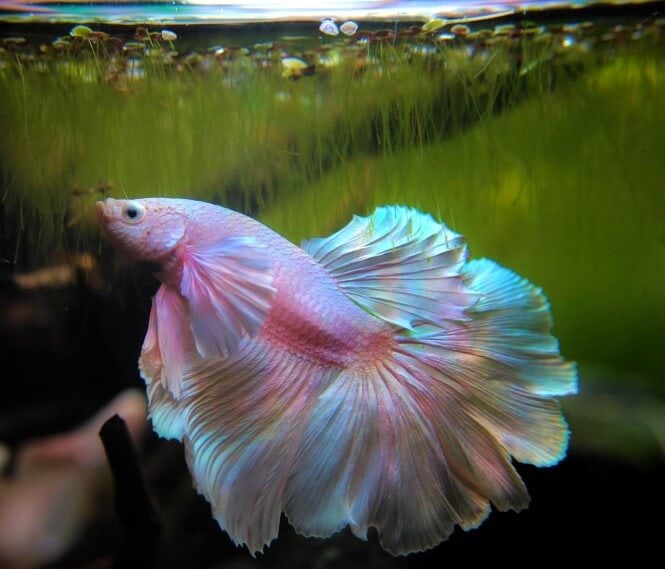
| Maximum Adult Size: | 2.7 inches but 3 inches are possible (between 6.8 and 7.6 cm) |
| Key Traits: | Territorial, can be either mellow or aggressive towards other fish and invertebrates, curious explorer, slow-swimmer |
| Temperature Range: | between 75 and 82 °F (between ~24 and ~28 °C) |
| Suitable for Beginners: | Yes |
The colorful Betta fish coming from the very numerous Betta genus reaches about 2.7 inches or 6.8 cm when fully grown, but it is not impossible for a healthy adult specimen to reach up to 3 in.
Aside from their small adult size, another feature that makes the Betta fish a good fit for a small aquarium is their natural behavior.
Betta fish prefer to slowly explore their surroundings and do not need to be in groups to feel confident.
These freshwater fish are also very hardy since they originate from rice paddies in Taiwan.
The rice paddies are places with shallow waters that are poor on oxygen.
The small Betta fish has its own complex breathing organ called a labyrinth, which allows it to gulp air directly from the water’s surface.
Given its small mature size, slow swimming behavior, and its resilience the Betta fish is my top recommendation for every beginner with a 5-gallon aquarium.
However, you should only keep a single Betta fish in a 5-gallon tank since the creature is strongly territorial.
A Betta is often hot-blooded by temper and it will display aggression towards other fish and invertebrates who dare to enter its territory.
Sometimes, you may turn out lucky and manage to find a timid Betta, but more often than not they will be aggressive.
Housing a Betta with other fish is possible, but it should not be attempted by people who don’t yet know the level of aggression that their small pet fish harbors.
Also, beginners should likely avoid putting a Betta with other nano fish in a 5-gallon tank.
If you’re new to the hobby yourself, you could try keeping your Betta with a couple of small shrimp.
This is easy to test, with some inexpensive Ghost shrimp from the pet store.
Simply put, a Betta eats different types of insects and crustaceans but if it does not give into its carnivorous nature the fish will not try to eat the shrimp.
Suggested aquarium gear for a Betta fish:
- Lights: Finnex Stingray for beginner aquarium plants
- Sponge filter: For example, XINYOU XY-2835 Mini Cylinder Soft Sponge
- Air pump for the sponge filter: Tetra Whisper Air Pump which you can get at both Chewy and Amazon
- To maintain a tropical water temperature: Each of these small heaters would do
Maybe read next: Aquanswers’ guide on the perfect tanks for Betta fish
3. Pygmy Sunfish – Elassoma sp.

| Maximum Adult Size: | 1 inch (2.5 cm) |
| Key Traits: | Peaceful, shorter life span, so you should look into breeding them |
| Temperature Range: | 68 to 74.3 °F (20 to 23.5 °C) |
| Suitable for Beginners: | Absolutely, as long as you can provide them with live foods and a planted tank |
The Pygmy Sunfish measures a paltry 1 inch (2.5 cm) and therefore it is one of the best candidates for a 5-gallon tank.
These Sunfish species are part of the Elassoma genus, which belongs to the Centrarchidae family of freshwater fish.
This pet fish is also hardy and rather easy to look after which makes it a suitable choice for a beginner.
First, the Pygmy Sunfish can survive in a small freshwater tank with low oxygen levels in the water.
It also flawlessly adapts to a variety of water conditions.
Another plus of the Pygmy Sunfish is that it’s a good fit for an aquarium without a heater, so consider it if you have a small cold water aquarium.
Anyway, the Pygmy Sunfish is more at home in a calm, densely planted fish tank.
In looks, this fish is especially attractive and even more so when the dominant males color up with their typical electric blue coloration.
The only challenge a Pygmy Sunfish keeper could face is providing it with live foods because the fish prefers it over prepared foods.
This fish could eat small pest snails, but a supply of micro-worms and insect larvae would be needed. Another good diet idea can be the population of small white worms that sometimes appear in aquariums with an overabundance of nutrients in the water.
Because of its carnivorous diet and small adult size of 1 inch, the Pygmy Sunfish is one of the best predatory fish you could put in a small tank.
Pygmy Sunfish can be kept in groups of 3 in a small 5-gallon aquarium, one male and two females.
Suggested aquarium gear for a trio of Pygmy Sunfish:
- Lights: Finnex Fugeray Planted Plus for a heavily planted tank
- Sponge filter: Something like the XINYOU XY-2835 Mini Cylinder Soft Sponge
- Air pump for the sponge filter: Tetra Whisper Air Pump (check it out at Chewy and Amazon)
4. Chili Rasbora – Boraras brigittae

| Maximum Adult Size: | 0.78 inches (2 cm) |
| Key Traits: | Peaceful, likes soft water, schooling |
| Temperature Range: | 75 to 82.4 °F (23.9 to 28 °C) |
| Suitable for Beginners: | No, these fish are sensitive to changes in water parameters and prefer a more acidic environment |
The Chili Rasbora, a native of the Indonesian blackwater rivers, is a peaceful small fish that can be put to live in a 5-gallon tank because adult specimens grow no more than 0.8 inches (2 cm).
The Chili Rasbora fish belongs to the small genus known as Boraras.
They may get timid if they are the single representative of their species, so it is better to keep them in a group.
These small freshwater fish are more docile than usually portrayed, and anyone who has actually kept them knows that.
Chili Rasbora fish are a schooling species but, fortunately, they do not actively school so a 5-gallon tank will comfortably accommodate about 10 to 12 of them.
They come in either orange or red colors and are arguably among the most brightly colored micro fish in the hobby.
You should feed Chili Rasbora fish with Cyclops, Daphnia, mini-worms, or crushed flakes.
To mimic their natural habitat, you could provide their tank with a handful of lush floating plants.
Indian almond leaves are also beneficial as the leaf makes the water in the aquarium more acidic, which is favorable for the Chili Rasboras.
From what I have observed first-hand, these fish are quite sensitive to back and forth changes in water parameters.
The current that the aquarium’s filter produces should be minimal.
5. Common Guppy fish – Poecilia reticulata
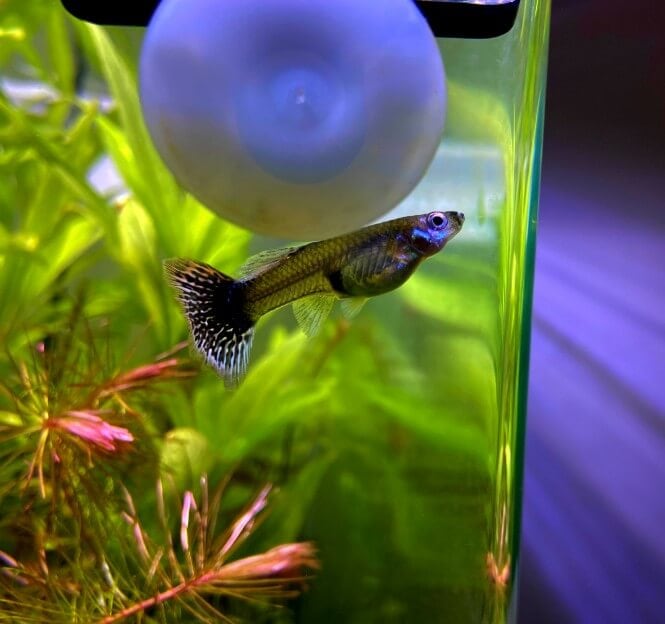
| Maximum Adult Size: | 1.4 inches (3.5 cm) for males and up to 2.4 (6 cm) for females |
| Key Traits: | Peaceful, fast breeder, may eat algae, likes hard water |
| Temperature Range: | between 72 and 80 °F or 22.2 and 26.6 °С |
| Suitable for Beginners: | Yes |
A male Common Guppy will grow to no more than 1.4 inches (3.5 cm), whereas females may reach up to 2.4 inches (6 cm).
However, these freshwater fish have very tiny mouths and do not eat a lot.
Their small size and relatively insignificant bioload make the Common Guppies one of the best pet fish from the genus Poecilia to put in a small aquarium.
Guppies are also peaceful and prefer to mind their own business instead of paying attention to their tank mates.
What guppies usually prefer to do in an aquarium is to actively seek food and to breed.
The Common Guppies are live-bearers that will breed at a very high pace.
If you’d like to keep Guppies in your new 5-gallon aquarium, then be mindful of their ever-growing population.
When the fish fry become old enough, relocate them to another tank, or bring them back to your local pet store.
You could put 3 to 4 Guppies in a 5-gallon tank, without worrying that you may be overstocking it.
Guppies may hang out with each other but do not school together.
Common Guppies are one of the best picks for pet fish that suit a beginner in the hobby.
This is because Guppies are very hardy, and make an excellent fish for a low-maintenance aquarium.
They also prefer hard water, which is convenient because most beginners use hard tap water to supply their fish tanks.
6. Dracula Minnow – Danionella Dracula

| Maximum Adult Size: | 0.65 inches (1.67 cm) |
| Key Traits: | Peaceful, active, and schooling fish |
| Temperature Range: | 66 to 78.8 °F (19 to 26 °C) |
| Suitable for Beginners: | Yes |
The Dracula Minnow fish measures a maximum of 0.65 inches when mature (close to 1.7 cm).
It prefers subtropical water temperatures which makes it one of the best freshwater fish that you can get for your small, unheated aquarium.
The Dracula Minnows are a part of the Danionella genus of danionin fish which contains some of the smallest fish.
This bizarre, tiny fish is almost colorless, so its veins and other internal organs may be easily seen.
The Dracula Minnow fish is peaceful in nature and since it remains so small it would not be a threat to any other ornamental creature in the aquarium.
This is an active, social fish and it will school, though loosely.
I recommend putting about 10 or so Dracula Minnow specimens in your 5-gallon fish tank.
Feed them with Daphnia or Tubifex.
7. Clown Killifish – Epiplatys annulatus
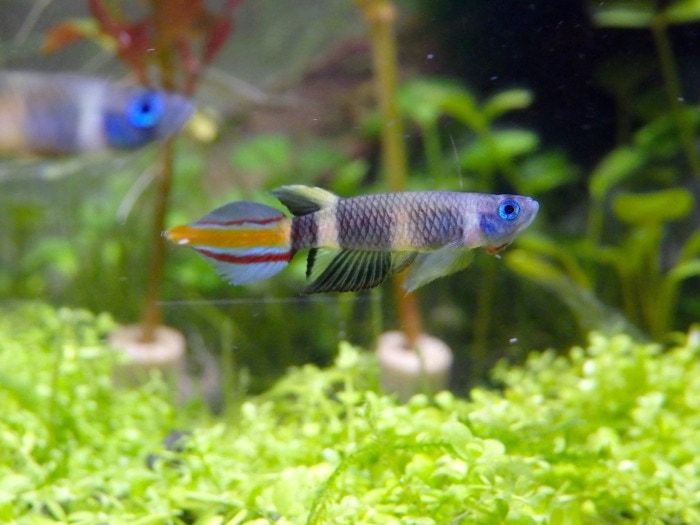
| Maximum Adult Size: | 1.4 inches or 3.6 centimeters |
| Key Traits: | Peaceful, micro-predator that may go after shrimp babies, top-dwellers, does well in a harem of 5 |
| Temperature Range: | 67 to 80 °F or 19.4 to 26.6 °C |
| Suitable for Beginners: | I would not recommend them to a first-time hobbyist, but anyone know has some practice with basic aquarium husbandry can keep them |
Averaging just about 1.4 inches when mature (3.6 cm), the Clown Killifish from the Epiplatys genus in the family Nothobranchiidae is among the smallest real Killifish species available to aquarists.
These fish have a unique tail shape and a spectacular coloration that contrasts well in heavily planted tanks.
The females share the impressive body colors of the males (except the tail) which is great because you can choose to have both sexes and breed the fish.
They are also one of my personal favorite nano fish.
Anyway, being small, the Clown Killifish have really tiny mouths and you should observe whether they can eat uncrushed flakes you give them.
Speaking of diet, I’ve found that these fish are not picky eaters, but they will appreciate some live foods.
Whenever I’ve kept them with shrimp my Clown Killifish would hunt down the shrimplets. However, unlike larger killifish species the Clowns would leave adult shrimp alone.
Anyhow, Clown Killifish are not schooling in the classical sense of the word but they tend to do better in groups of their own.
Given their small maximum size and swimming behavior I’d say that you can comfortably put 5 specimens in a single 5-gallon tank.
Author’s note: My experience has been that male Killifish can be very persistent when wooing females. The males would also fight with each other in small tanks. For this reason, I recommend getting four females and one male for your 5-gallon aquarium. This way the females won’t get too much harassment during courtship.
Finally, the Clown Killifish are top-dwellers and some are very motivated jumpers.
If you really insist on keeping them in an open-top tank then I’d recommend heavily populating it with floating plants.
The floaters should discourage jumping, but even then I’d expect the occasional Killie kamikaze.
Anyway, do additional research on Clown Killifish because there’s much more to be said about this species.
8. Least Killifish – Heterandria Formosa
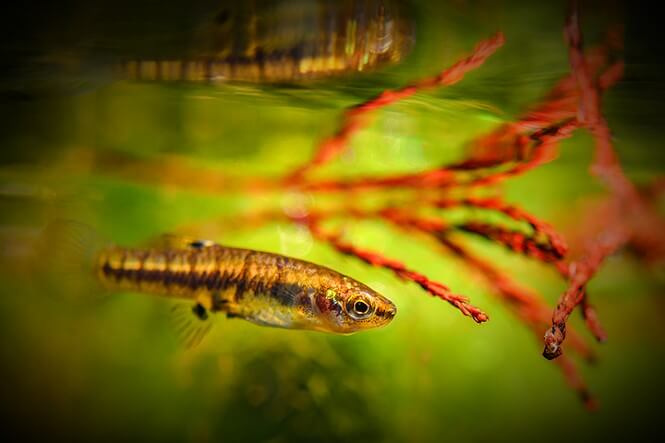
| Maximum Adult Size: | 1.2 inches (3 cm) but most will remain under 1 inch (2.5 centimeters) |
| Key Traits: | Peaceful, smallest livebearer in the world |
| Temperature Range: | 68 to 78 °F (20 to 25.5 °C) |
| Suitable for Beginners: | Yes, and I actually recommend that you try them if you’re new to the hobby |
The Least Killifish is considered the seventh tiniest freshwater fish in the world.
Coming from the Heterandria genus, the Least Killifish are relatives to the Guppies within the family Poeciliidae.
A male Least Killifish is a mere 0.8 inches (2 cm) while a female may reach up to 1.2 inches (3 cm).
The tiny size of this fish species makes them a fantastic option for stocking a 5-gallon tank.
The Least Killifish remains small in its adult life, so you won’t have to upgrade to a bigger tank later when it grows old.
You can put 7 to 8 Least Killifish specimens in your small 5-gallon tank.
The Least Killifish are extremely hardy and can adapt to fluctuating water conditions because that’s close to their natural habitat.
This trait of theirs makes them really easy to look after if you’re new to the hobby.
The low-maintenance Least Killifish is also friendly by temperament, so it may peacefully coexist with the other tank-mates such as dwarf shrimp.
On top of that, these freshwater fish aren’t picky about their food.
For these reasons, I consider the Least Killifish one of the best small fish for beginners overall.
The Least Killifish is a livebearing nano pet fish that gives birth sparingly and as such it will attempt to breed in your 5-gallon tank.
When the fry is old enough you should likely transition them elsewhere to avoid overcrowding the tank.
9. Sparkling Gourami – Trichopsis pumila
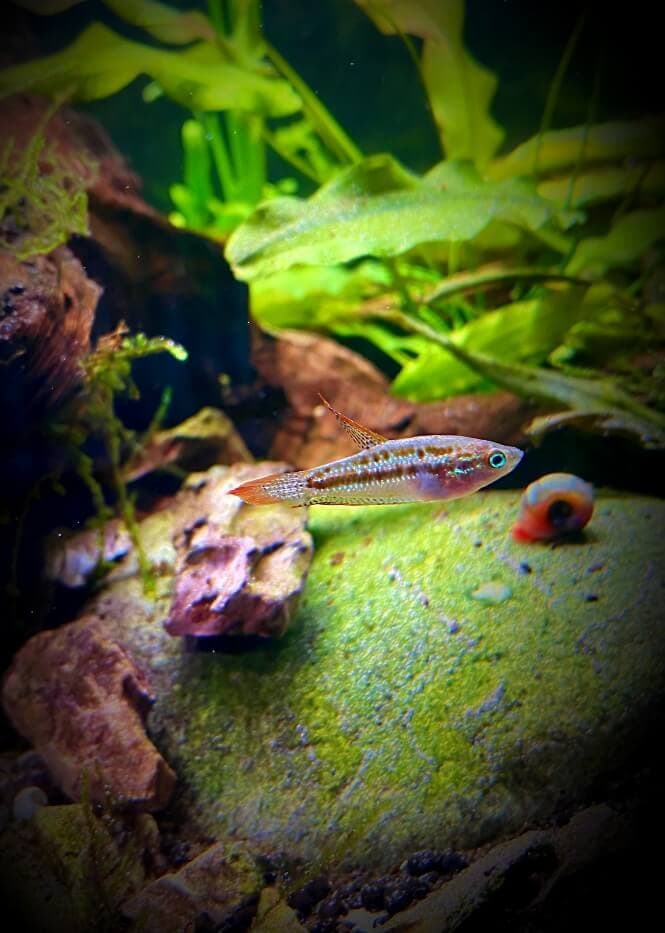
| Maximum Adult Size: | 1.5 inches or 3.8 centimeters |
| Key Traits: | Males could be aggressive among one another, but an overall peaceful fish when it comes to other tank mates |
| Temperature Range: | 72 to 81 °F or 22.2 to 27.2 °C |
| Suitable for Beginners: | Yes, as long as you make sure the tank is heavily planted and that there is only 1 male Sparkling Gourami |
The Sparkling Gourami fish measures a maximum of 1.5 inches or 3.8 cm and comes in blue, red, and green body colors.
This is typical for species of their genus Trichopsis, native to Southeast Asia.
Although not popular enough, this species is yet another excellent small fish that could live in a compact freshwater aquarium.
The Sparkling Gourami is also one of the best beginner fish to keep in a small volume of water because they are hardy, and therefore require low overall maintenance.
They literally sparkle, as the name suggests, and so they make a fantastic display in a tank.
Anyway, what’s important to remember with Sparkling Gouramis is that you should not keep more males than females.
This way you’ll reduce competition and the aggression that naturally follows.
If you could make sure that you’re getting just one male then you may keep a small group of 4 Sparkling Gourami fish in a small aquarium.
From my experience, if the 5-gallon tank is heavily planted you could safely put 1 male with up to 3 females in that space.
Two males won’t be able to “split” the territory of such a small tank and there will be aggression.
Also, the hideouts that a planted fish tank would provide help the Sparkling Gourami females to deal with the somewhat intense attention of the male.
These freshwater fish also enjoy hunting through the live plants, which is an additional benefit of having something like a dense Java Fern plant in their aquarium.
Maybe check out: The Top LED Aquarium Lighting for Plants
10. Least Rasbora – Boraras urophthalmoides
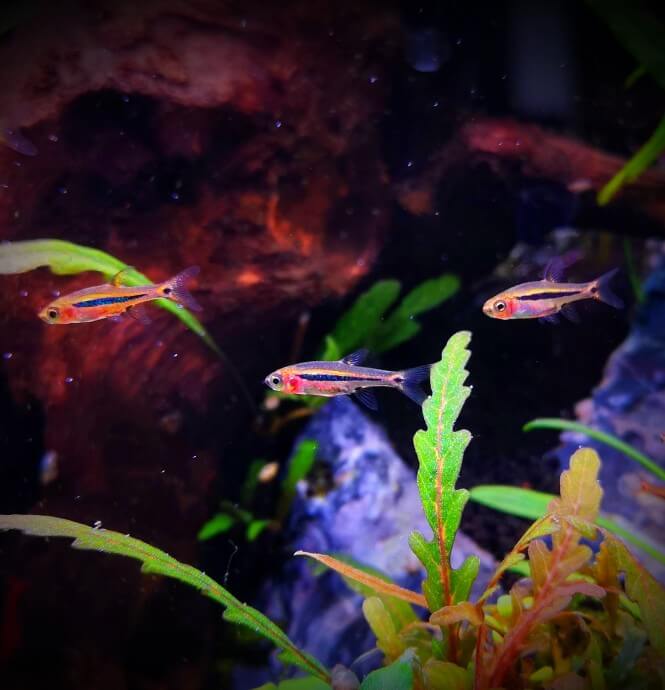
| Maximum Adult Size: | 1 inch or 2.5 cm |
| Key Traits: | Shy, peaceful, not actively schooling fish |
| Temperature Range: | 72 to 81 °F 22.2 to 27.2 °C |
| Suitable for Beginners: | Yes |
The Least Rasbora is one of the pet fish that can comfortably live in tiny 5-gallon tanks because it measures a mere 1 inch (or 2.5 centimeters) in body length when mature.
Same as the Chili Rasbora, the Least Rasbora is a member of the Boraras genus.
It is also known as the Exclamation Point Rasbora because of the dark pigment that runs horizontally on its clear body, ending at the base of the tail, where another dark spot is located (!).
This small, tropical pet fish is shy and somewhat uncomfortable when put in a tank with a large community of fish.
However, keeping a school of 8 to 10 Least Rasboras in a small, 5-gallon tank boosts their confidence, enabling them to school freely.
Same as with the Chili Rasboras, the Least Rasboras are falsely portrayed as fish who prefer to swim long straight distances.
In actuality, the Least Rasbora will slowly school in short intervals instead of speeding up, as a Zebra Danio would.
Anyway, the Least Rasbora fish are hardy enough to be suitable for a beginner in the aquarium hobby. Feed them on small insects and the like.
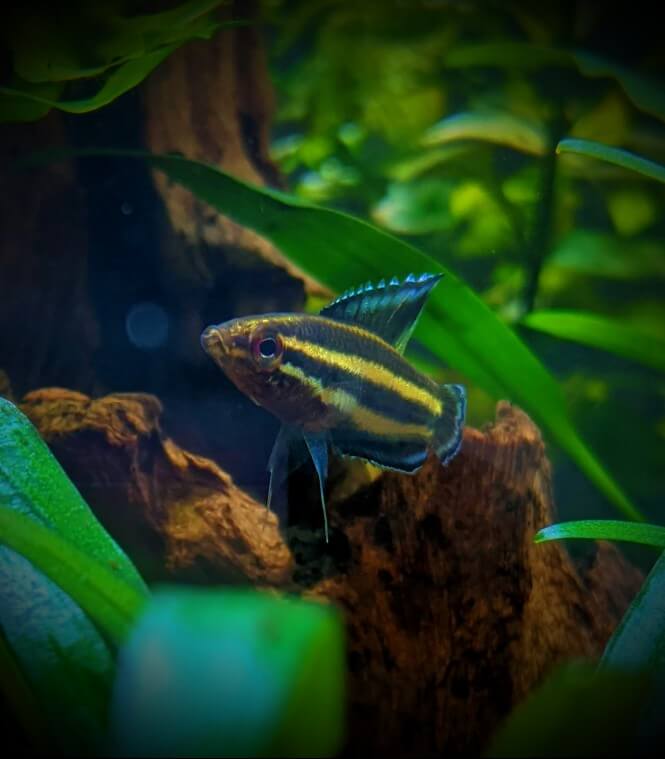
| Maximum Adult Size: | 1.5 inches (3.8 cm) |
| Key Traits: | Peaceful, but males are territorial among each other and may compete for female attention in a more aggressive way |
| Temperature Range: | 75 and 81 °F (23.9 to 27.2 °C) |
| Suitable for Beginners: | No, this pet fish prefers stable water conditions, which can be a challenge to achieve in smaller fish tanks |
The Licorice Gourami is a semi-docile freshwater fish from the Parosphromenus genus of gouramies, and measures only 1.5 inches (3.8 cm).
Therefore it can comfortably live in a small 5-gallon aquarium.
I recommend putting a single male with no more than two females in your small tank.
A male Licorice Gourami is smaller but more colorful than its female counterpart.
The white or bluish margin that borders the males’ fins really enhances their beauty.
The Licorice Gourami fish have a peaceful temperament and are rather shy.
Therefore, you should not house them with aggressive fish that may take advantage of the Gouramis’ small size.
In fact, the Licorice Gourami fish are better off in a species-only tank.
Ironically, the males do at times turn aggressive against each other over territories, which is why I recommend keeping no more than 1 male Licorice Gourami per one 5-gallon tank.
Having a labyrinth breathing organ, this freshwater fish dives to the water’s surface to breathe oxygen.
Anyway, the Licorice Gourami are more at home in a dimly lit tank that’s heavily decorated with live aquatic plants.
Also, remember to include caves in the decorations since these fish prefer to breed privately.
The Licorice Gourami is a micro-predator, so you can feed them on small live foods such as Daphnia, micro worm, and mosquito larvae.
12. Freshwater Pom Pom Crab – Ptychognathus Barbatus
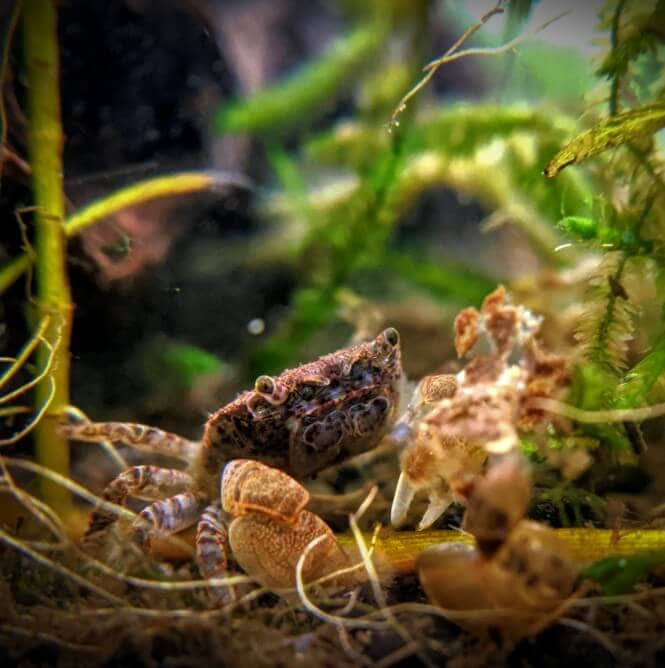
| Maximum Adult Size: | 1 inch (2.5 centimeters) |
| Key Traits: | Peaceful, active, burrowing in the sand, scavenger |
| Temperature Range: | about 71 to 81 °F (around 21.6 to 27.2 °C) |
| Suitable for Beginners: | Yes |
The freshwater Pom Pom Crab from the crab genus Ptychognathus, named after the patches of hair that grow on its front claws, is generally friendly, peaceful, and measures only 1 inch when mature (around 2.5 cm).
For this reason, the freshwater Pom Pom is a tiny aquatic invertebrate that may fit the community of a small 5-gallon tank.
This micro crab is super active, and ever on the move, exploring the tank as far as its slender legs can go.
Because of their activity level, I recommend keeping 2 to 4 specimens in a tank that only holds 5 gallons of water.
Although they are aquatic, freshwater Pom Pom Crabs may occasionally live on land.
They are also escape artists as I’ve heard instances where they have crawled out of the tank.
For that reason, you should seal the tank’s top.
You should have a sandy substrate to keep Pom Poms busy because they love burrowing and tearing through the sand with their tiny claws.
I recommend putting some floating plants in your 5-gallon Pom Pom Crab tank because these crustaceans may uproot a substrate-dependent plant as they burrow.
Tank mate combinations include many freshwater shrimp varieties like the Amano shrimp, the Cherry shrimp, and the Bamboo shrimp.
However, a Pom Pom Crab is an opportunistic omnivore which means that it will readily feed on shrimp fry and other micro tank inhabitants if it gets an opportunity.
These freshwater nano crabs may also eat plant foods like algae and meaty foods such as bloodworms and tiny aquarium snails.
13. Pea Puffer Fish – Carinotetraodon travancoricus

| Maximum Adult Size: | 1.5 inches (3.8 cm) |
| Key Traits: | Semi-aggressive, guards its territory against other tank mates and not just their own kind; prefers live foods, eats freshwater snails |
| Temperature Range: | 76 and 78 °F or 24.4 and 25.5 °C |
| Suitable for Beginners: | Yes |
Also known as Dwarf Puffer Fish or Malabar Pufferfish, the Pea Puffer, member of a genus known as Carinotetraodon, grows to a maximum of 1.5 inches (3.8 cm).
This cool freshwater fish has rather large eyes that independently turn around as the fish hovers.
The small Pea Puffer has a bulldog look on its face, a tadpole appearance overall, and moves like a helicopter, puffing or inflating like a balloon when threatened.
Like other pufferfish species, the Pea Puffer is highly intelligent (by fish standards, that is).
It will be the first to notice you when you enter the room.
It then draws near you, expecting a treat. This fish is a restless explorer and its curiosity knows no bounds.
For this reason, most experts would recommend that you keep just 1 Pea Puffer in a 5-gallon aquarium.
Pea Puffers are omnivores but enjoy eating snails, blackworms, and other fleshy foods more than a vegetable menu.
These nano pufferfish tend to eat a lot, but you should not be tempted to overfeed them.
As expected, they also discharge more waste than other pet fish of their size, which is another reason you should only house a single specimen in a small space such as the 5-gallon tank.
Despite these antisocial traits, the Dwarf Pufferfish is not so difficult to handle that it cannot be kept by a beginner.
Its small adult size and hardy nature make the Pea Puffer one of the best tropical freshwater puffer fish you can ever get to grace a small aquarium.
14. Cardinal Sulawesi Shrimp – Caridina dennerli

| Maximum Adult Size: | 1 inch (2.5 centimeters) |
| Key Traits: | Peaceful, social, does best in its own biotope tank |
| Temperature Range: | 77 – 87 °F (25 – 30.5 °C) |
| Suitable for Beginners: | No |
An adult Sulawesi Shrimp measures 1 inch (2.5 cm) in total but that’s not the only reason you’d want them to populate your 5-gallon tank.
These dwarf freshwater shrimp have earned my admiration because of their gorgeous appearance.
Although so beautiful, the Cardinal Sulawesi shrimp is a latecomer in the aquarium industry as it was discovered just a couple of years ago.
For that reason, this species of freshwater shrimp from the Caridina genus is still hard to come by in pet stores, but there are some reliable online fish and invertebrate retailers that you can try.
These freshwater crustaceans are peaceful, social, and small enough to qualify for a community in a small aquarium of 5 gallons.
However, I would not recommend Sulawesi Shrimp to a beginner because they require optimal water conditions, unlike other dwarf shrimp.
Anyway, the Cardinal Sulawesi Shrimp is one of the best algae-eating invertebrates that can live in a small aquarium.
Each of these shrimp will eat most of the time and they will even consume the decaying plant parts, thus helping to clean the tank further.
You will spot your Sulawesi shrimp scavenging the substrate, plants, or rocks for algae.
In fact, you do not have to feed them anything since these foods sustain it well.
Tip: The Cardinal Sulawesi Shrimp feel excellent in a dense carpet of aquarium grass, such as the Dwarf Hairgrass.
15. Brevis Shell Dweller – Neolamprologus brevis
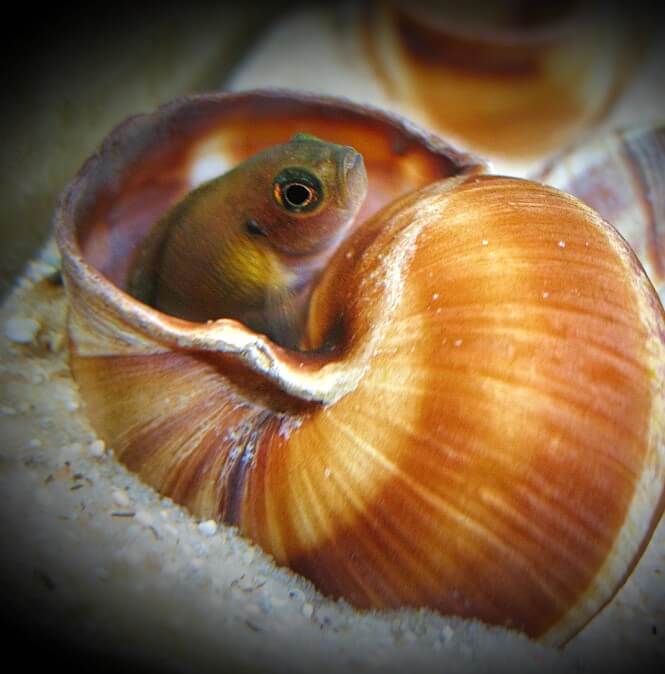
| Maximum Adult Size: | 2.1 inches or around 5.3 cm |
| Key Traits: | Peaceful until provoked, lives in empty snail shells |
| Temperature Range: | 77 to 79 °F (25 to 26 °C) |
| Suitable for Beginners: | Yes |
A native of Lake Tanganyika, and a member of the largest genus in the lake, named Neolamprologus, the Brevis Shell Dweller is a dwarf cichlid species that has a maximum size of 2.1 inches or 5.3 centimeters.
It is also known as Lamprologus Brevis or Brevis Shellie Cichlid.
Your 5-gallon tank should have more empty snail shells than Shell Dwellers so that the fish can freely choose which shells should become their small real estate.
The substrate should be sandy and quite deep because the Brevis Shell Dwellers bury the shells in the sand partially.
Here’s an example of the aquarium setup that Brevis Shell Dweller cichlids would need to thrive:

Normally, if you keep several of them, they soon form a colony.
However, for your 5-gallon tank, I’d recommend that you only keep a single pair.
Although tiny, a Brevis Shell Dweller Cichlid puts up a spirited fight no matter how big the intruder is.
If you put your hand near its shell, it comes out and attacks it with bites until you retreat.
Doing that is not recommended, since it may stress the shell-dwelling cichlids.
Anyway, in my observations, the Brevis Shell Dwellers suit a beginner because once you provide them with the shells and the right water conditions, they are at home.
With everything in place, this freshwater fish can clock 8 to 10 years in your small tank, so buying a pair is a long-term investment.
Brevis Shell Dweller Cichlids can eat frozen or live foods like bloodworms and blackworms but are omnivorous in nature and will eat a variety of commercial foods.
Check out this list of top-rated foods for Cichlid fish to get some more ideas.
16. Mexican Dwarf Crayfish – Cambarellus patzcuarensis
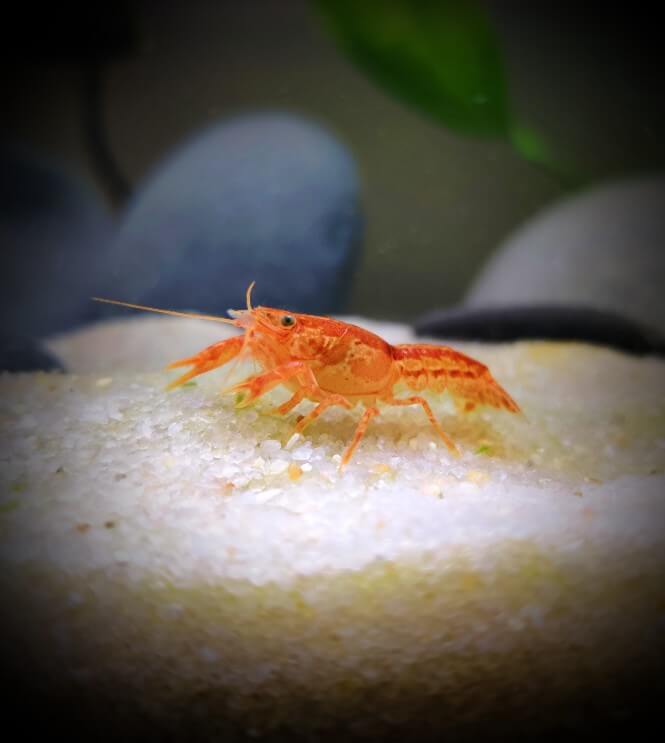
| Maximum Adult Size: | about 2 inches or 5 centimeters |
| Key Traits: | Highly aggressive, an opportunistic omnivore, active |
| Temperature Range: | 64 – 74 °F (17.7 to 23.3 °C) |
| Suitable for Beginners: | Yes |
An adult Mexican Dwarf Crayfish is hardly more than 2 inches or 2.5 centimeters, however, you should not keep more than one specimen in a 5-gallon tank.
As the name indicates, these species from the Cambarellus genus, are found in Mexico.
Though small in size, the Mexican Dwarf Crayfish come with huge personalities.
They are super aggressive and opportunistic feeders.
Your larger aquarium snails may lose an eye or two and your shrimp and smaller snails will get outright destroyed.
Even small fish that sleep on the bottom of the tank are not safe in a small tank with Mexican Dwarf Crayfish.
For this reason, I recommend that you only have one Mexican Dwarf Crayfish per 5-gallon tank.
Anyway, these hot-tempered crustaceans are an excellent alternative to small fish.
It is fun watching one crawl about.
I have noticed that kids tend to like watching them.
So if you have kids, consider keeping a Mexican Dwarf Crayfish.
These mini-lobsters are easy to maintain, and therefore a suitable pet for a beginner with a small aquarium.
Just know that it is likely pointless to keep this freshwater crustacean in a planted tank, because it may eat some of the plants and uproot the remaining ones.
The Mexican Dwarf Crayfish is a nocturnal omnivore in its natural habitat, feeding on snails, worms, and plants such as algae or seaweed.
Provide yours with multiple hiding places because it will hide its food leftovers behind caves, rocks, etc.
17. Scarlet Badis – Dario dario

| Maximum Adult Size: | Close to 1 inch, but usually around 0.8 inches (2 cm) |
| Key Traits: | Peaceful, timid micro-predator, but males will get aggressive towards one another |
| Temperature Range: | between 68 and 78.8 °F (between 20 and 26°C) |
| Suitable for Beginners: | No |
An adult Scarlet Badis fish specimen barely grows to 1 inch (2.5 cm) and more often than not remains at around 0.8 inches (2 centimeters) in body length.
The Scarlet Badis is associated with the fish genus called Dario, native to streams and freshwater pools in China, Northeastern India, and Myanmar.
This beautiful freshwater fish rarely requires a heater and is timid and peaceful when it comes to its temperament.
Since you need to maintain their water parameters and diet diligently, it may not be a good idea to go for the Scarlet Badis if you are a beginner in the aquarium hobby.
Although tiny, the Scarlet Badis is a micro-predator, so make sure its tank-mates are not smaller than its mouth.
That being said, these pet fish prefer live foods over frozen ones.
Put your Scarlet Badis in a densely planted tank that has hideouts, rocks, and driftwood decorations for refuge whenever the fish feel intimidated.
Having aquatic plants in a setup with these small fish is essential for their wellbeing.
A 5-gallon aquarium can accommodate a mating pair of Scarlet Badis, but never 2 male specimens, as they fight for territory will prove lethal for one of the males.
18. Mystery Snail – Pomacea bridgesii

| Maximum Adult Size: | 2 inches (around 5 cm) |
| Key Traits: | Peaceful, somewhat messy |
| Temperature Range: | 67 to 81 °F (19.4 to 27.2 °F) |
| Suitable for Beginners: | Yes |
On average, an adult Mystery Snail shell measures 2 inches in diameter (5 cm).
Mystery snails which are part of the Pomacea genus are either creamy white or brown, though others have mixtures of black stripes.
They are also known as “[color] mystery snails” or “apple snails”.
This freshwater invertebrate is peaceful, so it should live with equally calm tank mates in the aquarium.
You may put up to 2 Mystery snails in a 5-gallon tank, however, this type of snail is somewhat messy, so having just one is likely better.
The tank should have a heater and a filter for the Mystery Snail to thrive.
Mystery snails are suitable for a beginner because they tolerate varying tank conditions, provided the changes in the water’s parameters are not instantaneous.
Anyway, you should likely seal all the holes of the tank because this small invertebrate has a tendency of escaping its aquarium.
A Mystery snail comes out to eat mostly when the lights are off.
19. Red Cherry Shrimp – Neocaridina davidi

| Maximum Adult Size: | 1.5 inches (3.8 cm) |
| Key Traits: | Peaceful, algae-eating critters, fast multipliers |
| Temperature Range: | 68 and 84 °F (20 to 28.8 °C) |
| Suitable for Beginners: | Yes |
A Red Cherry Shrimp measures 1.5 inches (3.8 cm), has almost no bioload and picks on soft green algae.
These traits make the Red Cherry shrimp, one of the species that the Neocaridina genus contains, an excellent addition to a 5-gallon tank, as long as there are a lot of live plants in there.
Note that Red Cherry Shrimp may not be the best choice if you want a hair algae eater for your small tank.
These crustaceans do feed on the hair algae but it’s not nearly enough to get rid of the problem.
I’d recommend that you keep 4 Cherry shrimp in a 5-gallon aquarium because they will breed and multiply their numbers fast.
If you want to keep a stable colony of these algae eaters, you need to choose peaceful tank mates like snails or Amano shrimp that will not prey on the Red Cherries.
20. Ramshorn Snail – Planorbidae

| Maximum Adult Size: | 0.75 inches (1.9 cm) on average but some may reach 1 inch (2.5 cm) |
| Key Traits: | Peaceful, omnivorous, will eat algae, may munch on the more sensitive live plants, fast multipliers |
| Temperature Range: | 60 to 84 °F (15.5 to 28.8 °F) |
| Suitable for Beginners: | Yes |
A Ramshorn Snail measures close to an inch in diameter (2.5 cm).
It is fun watching one float to the water’s surface because some air got trapped in its shell.
These freshwater snails have lungs and therefore breathe air directly like other air-breathing snails in the Planorbidae family.
Anyway, the peaceful Ramshorn Snail is a low-maintenance invertebrate because it is hardy enough to adapt to various water conditions, provided there is consistency.
For these reasons, Ramshorn Snails are a good option for a beginner who’s starting with a 5-gallon, freshwater tank.
Ramshorn Snails also serve an essential purpose in your small tank: they feed on the algae, and decaying organic matter.
In the absence of algae and uneaten fish food, this aquarium snail may eat some of your aquatic plants, especially if you keep a large population.
However, there’s usually plenty of organic matter to feed on in an aquarium.
Since Ramshorn snails reproduce fast and therefore you should likely put 1 to 4 specimens in a 5-gallon aquarium.
These snails are really small and do not have a huge bioload, but you should be prepared to “donate” some when their mass reproduction takes place.
Dealing with exploding populations of aquarium snails is not something many aquarists are fond of…
Anyway, the Ramshorn snail will act as a good alternative to a bottom-feeder in a small fish tank.
21. Red Neon Blue-Eyed Rainbowfish – Pseudomugil luminatus

| Maximum Adult Size: | 1.5 inches or close to 3.8 cm, but usually remains at 1.2 inches (3 cm) |
| Key Traits: | Peaceful, timid, prefers the company of its own kind |
| Temperature Range: | 72 to 84 °F (22.2 to 29 °C) |
| Suitable for Beginners: | Not with this setup, because pristine water is needed for the Blue-Eyed Spotted Rainbowfish to thrive and this may be difficult to achieve in a small tank |
Measuring 1.5 inches (3.8 cm) in full body length, the Blue-Eyed Spotted Rainbowfish is small enough to be looked after in a small freshwater tank.
This freshwater fish from the Pseudomugil genus distributed in freshwater rivers and streams in Australia and New Guinea likes to live in an aquarium with floating or substrate-rooting live plants.
I’d usually recommend housing Blue-Eyed Spotted Rainbowfish in a 10 or 15-gallon tank, but having a mating “harem” in a 5-gallon tank, that’s heavily planted, is doable.
Keeping a small school of 3 females and 1 male Blue-Eyed Spotted Rainbowfish would be acceptable for one such setup.
Anyway, this tiny fish is peaceful and rather timid and will not bother other tank mates.
That said, I prefer keeping Blue-Eyed Spotted Rainbowfish in a species only tank.
While these fish are relatively hardy, they do need clear water and are not “low-maintenance” when kept in a small tank.
In this case, you’d need to stay on top of the water changes, make sure the temperature of the water is stable and that the aquarium remains cycled at all times.
22. Salt and Pepper Corydoras – Corydoras habrosus

| Maximum Adult Size: | 1.4 inches or 3.56 cm |
| Key Traits: | Needs to be kept in groups of 5, bottom-dweller with a personality |
| Temperature Range: | 72 – 79 °F (22 – 25 °C) |
| Suitable for Beginners: | Only if you get the right 5-gallon tank (explained below) |
So nano Corydoras can be kept in a 5-gallon tank but with a caveat.
I’ll start explaining from afar but have patience with meand you’ll be rewarded:
Most cory catfish are social and need to be kept in groups of at least 5 to thrive.
This eliminates the possibility of keeping them in most small tanks.
Most corydoras species, however, are bottom dwellers.
This means they mainly inhabit the bottom of the tank.
What you’re concerned when keeping bottom-dwelling fish is the bottom footprint of your small tank.
As I mentioned earlier, a standard 5-gallon tank has the bottom footprint of 16 * 8 inches, which is not enough to keep a group of bottom-dwelling fish.
However, there are 5-gallon tanks that are irregularly shaped which provide more bottom footprint than usual.
One such tank is the Lifeguard Aquarics Full View 5-Gallon tank, which has a bottom footprint of 13.5 * 13.5 inches (34.3 * 34.3 cm).
This is roughly 50% more bottom area than a regular 5-gallon tank.
If you get this tank you’ll be able to keep a group of Salt and Pepper corydoras happy.
The Salt and Pepper Cory catfish grow to about 1.4 inches in length (3.56 cm) which should be fine in such a tank.
At this point, some fishkeepers may chime in and say “yeah, but what about the Pygmy Cory which only grows to about 1 inch (2.4 cm) – why not recommend them instead?”.
My answer would be that Pygmy Cories are more of a swimming cory and typically use the middle water column as well.
The Salt and Pepper corydoras are more docile in this regard and like to hang out on the bottom.
23. African Dwarf Frog – Hymenochirus spp.

| Maximum Adult Size: | 3 inches (7.62 cm) |
| Key Traits: | Docile, poor eyesight, exotic appearance |
| Temperature Range: | 72 – 78 °F (22 – 25 °C) but can temporarily withstand temperatures of 68 °F (20 °C) |
| Suitable for Beginners: | No, unless you do some serious reading on the species |
African Dwarf Frog is an umbrella term for a genus of tiny freshwater frogs.
The African Dwarf frog grows to about 3 inches (7.62 cm).
Although chunky by the standards of animals that can live in a small tank, you could actually keep 2 frogs in a 5-gallon.
The caveat is that the tank should not harbour any other fish or shrimp.
The African Dwarf Frogs are mainly docile and don’t move much which makes this possible.
They will likely hide most of the time and show up here and there.
To be frank, African Dwarf Frogs have somewhat boring personalities as an aquarium pet but look really cool.
If you’re into more exotic freshwater pets you would probably love having 2 of these in your small tank.
Keep in mind that African Dwarf Frogs are not something to start in the hobby with, unless you do some serious reading on how to handle them and what diseases they are susceptible to.
Starting a Small, 5-Gallon Aquarium the Proper Way

Your new freshwater fish and critters will consume food, which they will then excrete as waste products in the tank.
The uneaten food leftovers, decaying algae, and the dead plant leaves also slowly decompose in your tank, adding to the waste quantity.
The smaller your fish tank, the quicker it may become overwhelmed with this waste.
Additionally, more bioload means more waste output per fish as some species are messier than others.
Eventually, the organic waste in your new aquarium degrades into Ammonia (NH3), which is lethal to aquatic fish and invertebrates. For this reason, the Ammonia levels in a tank should always be kept at 0 ppm.
Anyhow, the Nitrogen cycle begins at this point.
Different sets of beneficial bacteria that live in the water will transform the Ammonia into Nitrates. Nitrate is relatively harmless when kept low through water changes.
That marks the end of the Nitrogen cycle.
Before a fish tank becomes inhabitable it needs to go through the Nitrogen cycle so that the beneficial bacteria could process the toxic Ammonia from fish waste.
If left to nature, this process takes about 6 weeks on average and is called “aquarium cycling”.
However, biotechnology has made it possible for you to shorten it to about two weeks, through the help of some beneficial bacteria products.
A speedy aquarium cycling is non-negotiable if you’re eager to start your new 5-gallon tank and put fish in it as soon as possible.
I’d usually recommend going with Tetra SafeStart Plus for speeding the process up, but you could visit the link above to get familiar with other aquarium bacteria starters as well.
From then on, it’s a matter of having the core equipment a fish tank needs to function properly.
Maintaining a Small Tank Can Be Tricky
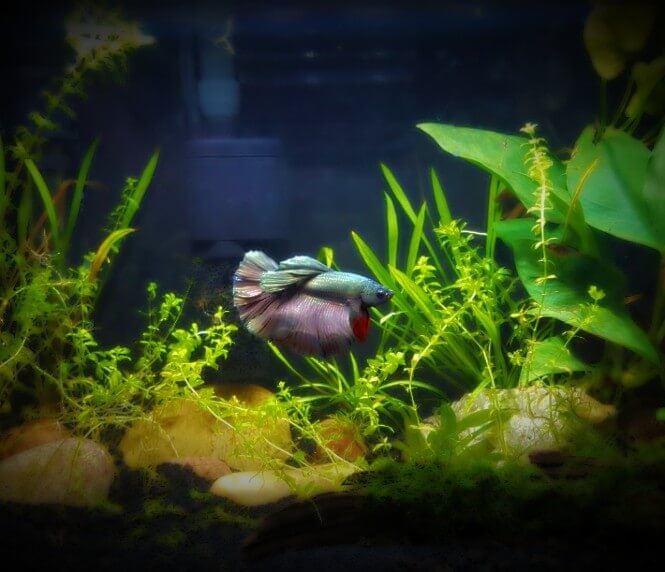
You also should bear in mind that small tanks are very sensitive to seemingly insignificant changes in their water chemistry.
A slight, sudden change in water parameters could prove fatal to your freshwater fish and invertebrates.
Bigger fish tanks can absorb many of the shockwaves resulting from pollution because they have a large volume of water.
A 5-gallon aquarium has no such luxury, so you have to be at the top of your game to manage the small tank successfully.
A good way to maintain pristine water quality in such a setup is by putting a lot of live plants in it.
Floating plants, in particular, do a very good job at sucking up excess Ammonia, Nitrite, or Nitrate from the aquarium’s water.
Recommended to read next:
- How Many Fish Can Be Put in a 3-Gallon Tank?
- Best Freshwater Fish for a 10-Gallon Tank
- Best Saltwater Fish for a 10-Gallon Tank
- Best Saltwater Fish for a 20-Gallon Tank



